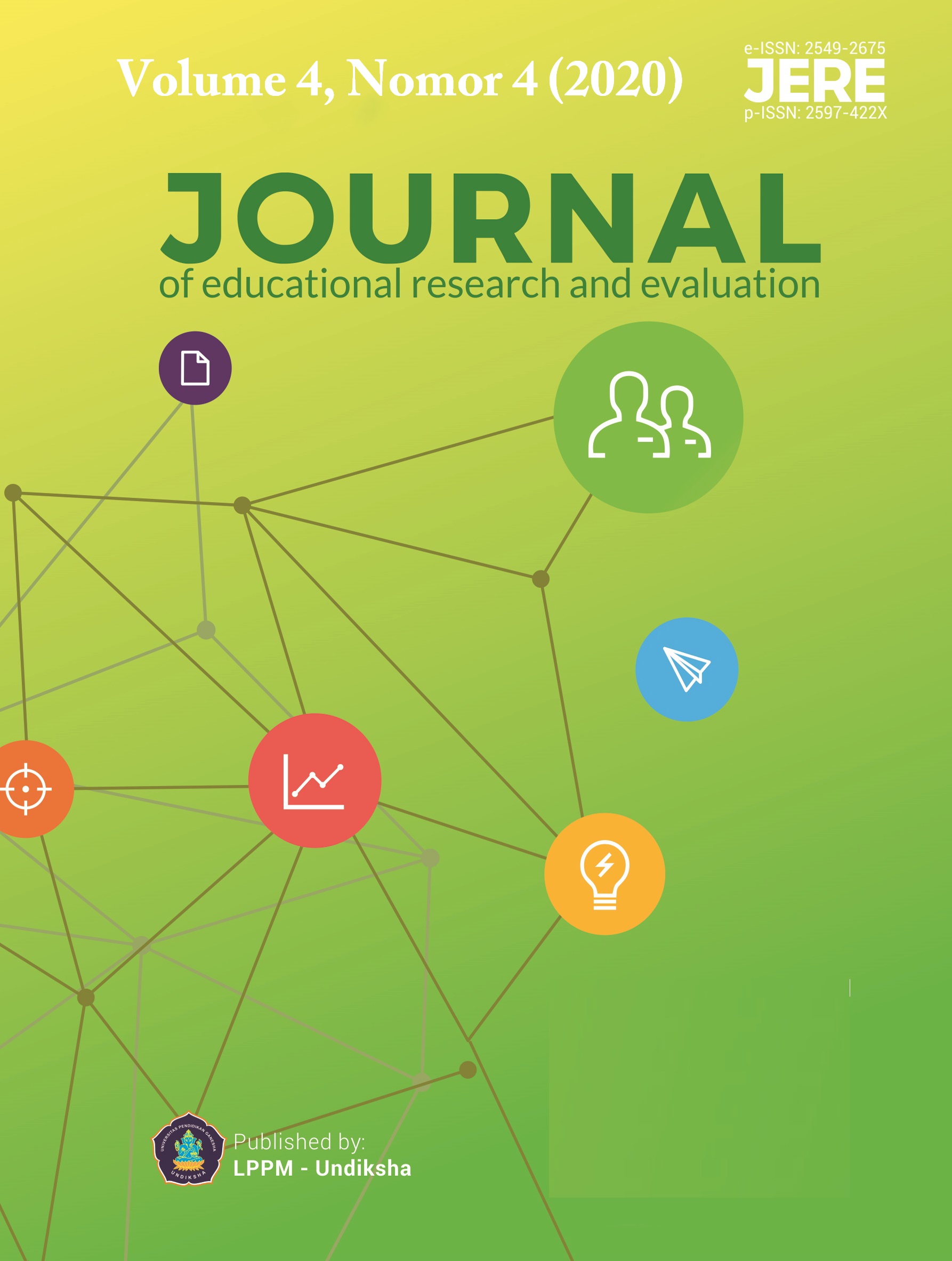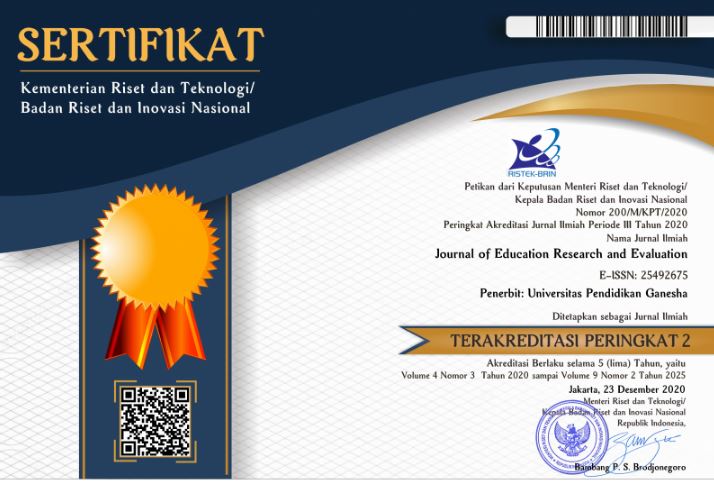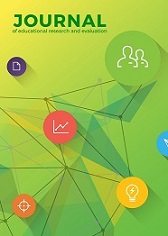The Development of Interactive Multimedia Learning in Information and Communication Technology Subjects
DOI:
https://doi.org/10.23887/jere.v4i4.29931Abstract
Learning media is an important learning component. Therefore, teachers must able to develop instructional media that can improve student abilities. One of the learning media that supports these goals was interactive multimedia. This study aimed to develop valid, practical, and effective interactive multimedia learning on Information and Communication Technology subjects. This research was research and development. The development model used was a 4-D model, which consists of defining, designing, developing, and disseminating stages. The defined stage was carried out with curriculum analysis, material analysis, and student analysis. The design stage was carried out by designing the learning media. At the development stage, validity tests were carried out through validation sheets of learning media, practicality tests through media application observation sheets, teacher and student response questionnaires, effectiveness tests obtained from the knowledge competency assessment. The disseminated stage was carried out by spreading the device. The analysis results showed that the Interactive learning media in Information and Communication Technology subjects have been tested and got a valid score (89.25%), according to the teacher's response (90.23%) in very practical category, students’ response (90.09%). The response was in the very practical category. With this score, interactive multimedia is categorized as practical and effective learning media.
References
Azizah, Nur. 2010. Karakteristik CD Multimedia Interaktif. (Online). http://anis- azizah.blogspot.com/2010/07/karakteristik-cd-multimedia-interaktif.html. Diakses tanggal Januari 2015.
Agustina, R., & Sitompul, H. (2015). Pengaruh Media Pembelajaran dan Gaya Belajar Terhadap Hasil Belajar Biologi. Jurnal Teknologi Informasi & Komunikasi dalam Pendidikan. Jurnal Teknologi Informasi & Komunikasi Dalam Pendidikan, 2(1), 1–14.
Amkas, S. I. ., Tegeh, I. M., & Mahadewi, L. (2017). Pengembangan Media Ludo Word Game Siswa Kelas IV SDN Banjar Bali Tahun Pelajaran 2017/2018. Jurnal Edutech Undiksha, 8(2).
Arisman, A. A. (2016). Penerapan Pembelajaran Kooperatif Tipe Stad Dengan Metode Praktikum Dan Demonstrasi Multimedia Interaktif (Mmi) Dalam Pembelajaran Ipa Terpadu Untuk Meningkatkan Literasi Sains Siswa. Edusains, 7(2), 179–184. https://doi.org/10.15408/es.v7i2.1676
Fanny, A. M., & Suardiman, S. P. (2013). Pengembangan Multimedia Interaktif untuk Mata Pelajaran Ilmu Pengetahuan Sosial (IPS) Sekolah Dasar Kelas V. Jurnal Prima Edukasia, 1(1), 1. https://doi.org/10.21831/jpe.v1i1.2311
Hakim, A. R., & Windayana, H. (2016). Pengaruh penggunaan multimedia interaktif meningkatkan hasil belajar siswa SD. EduHumaniora | Jurnal Pendidikan Dasar Kampus Cibiru, 4(2), 1–13.
Harjono, A., Gunawan, & Sutrio. (2015). Multimedia Interaktif dalam Pembelajaran Konsep Listrik Bagi Calon Guru. Jurnal Pendidikan Fisika Dan Teknologi, 1(1), 9–14.
Husein, S., Herayanti, L., & Gunawan, G. (2017). Pengaruh Penggunaan Multimedia Interaktif Terhadap Penguasaan Konsep dan Keterampilan Berpikir Kritis Siswa pada Materi Suhu dan Kalor. Jurnal Pendidikan Fisika Dan Teknologi, 1(3), 221. https://doi.org/10.29303/jpft.v1i3.262
Istiqlal, M. (2017). Pengembangan Multimedia Interaktif Dalam Pembelajaran Matematika. JIPMat, 2(1). https://doi.org/10.26877/jipmat.v2i1.1480
Kurniasih, I., & Sani, B. (2014). Sukses Mengimplementasikan Kurikulum 2013 (1st ed.). Kata Pena.
Lia, L. (2013). Multimedia Interaktif Sebagai Salah Satu Sains. 132–140.
Mulyasa, E. (2014). Pengembangan dan Implementasi Kurikulum 2013 (5th ed.). Pt Remaja Rosdakarya.
Muyaroah, S., & Fajartia, M. (2017). Pengembangan Media Pembelajaran Berbasis Android dengan menggunakan Aplikasi Adobe Flash CS 6 pada Mata Pelajaran Biologi. Innovative Journal of Curriculum and Educational Technology, 6(2), 79–83.
Novitasari, D. (2016). Pengaruh Penggunaan Multimedia Interaktif Terhadap Kemampuan Pemahaman Konsep Matematis Siswa. FIBONACCI: Jurnal Pendidikan Matematika Dan Matematika, 2(2), 8. https://doi.org/10.24853/fbc.2.2.8-18
Pravitasari, S. G., & Yulianto, M. L. (2018). Penggunaan Multimedia Interaktif Dalam Pembelajaran Bahasa Inggris (Studi Kasus Di Sdn 3 Tarubasan Klaten). Profesi Pendidikan Dasar, 1(1), 37. https://doi.org/10.23917/ppd.v1i1.3825
Puji, K., Gulo, F., & Ibrahim, A. (2014). Pengembangan Multimedia Interaktif Untuk Pembelajaran Bentuk Molekul Di Sma. Jurnal Penelitian Pendidikan Kimia: Kajian Hasil Penelitian Pendidikan Kimia, 1(1), 59–65.
Seruni, R., Munawaoh, S., Kurniadewi, F., & Nurjayadi, M. (2019). Pengembangan Modul Elektronik (E-Module) Biokimia Pada Materi Metabolisme Lipid Menggunakan Flip Pdf Professional. Jurnal Tadris Kimiya, 4(1), 48–56. https://doi.org/10.15575/jtk.v4i1.4672
Shoimin, A. (2014). Model pembelajaran Inovatif dalam Kurikulum 2013. AR-RUZZ MEDIA.
Sinica, A. P. (2013). Pengimplementasian Media Pembelajaran Berbasis Multimedia Interaktif Pada Mata Pelajaran Matematika Di Engimplementasian Media Pembelajaran Berbasis Multimedia Interaktif Pada Mata Pelajaran Matematika Di Sekolah Dasar. 50(5), 131–149.
Trianto. (2007). Model-model Pembelajaran Inovatif Berorientasi Kontruktivistik (1st ed.). Prestasi Pustaka.
Zainiyati, H. S. (2017). Pengembangan Media Pembelajaran Berbasis ICT: Konsep dan Aplikasi pada Pembelajaran Pendidikan Agama Islam. Kencana.
Downloads
Published
How to Cite
Issue
Section
License
Authors who publish with the Journal of Evaluation and Research in Education (JERE) agree to the following terms:
- Authors retain copyright and grant the journal the right of first publication with the work simultaneously licensed under a Creative Commons Attribution License (CC BY-SA 4.0) that allows others to share the work with an acknowledgment of the work's authorship and initial publication in this journal.
- Authors are able to enter into separate, additional contractual arrangements for the non-exclusive distribution of the journal's published version of the work (e.g., post it to an institutional repository or publish it in a book), with an acknowledgment of its initial publication in this journal.
- Authors are permitted and encouraged to post their work online (e.g., in institutional repositories or on their website) prior to and during the submission process, as it can lead to productive exchanges, as well as earlier and greater citation of published work. (See The Effect of Open Access)











